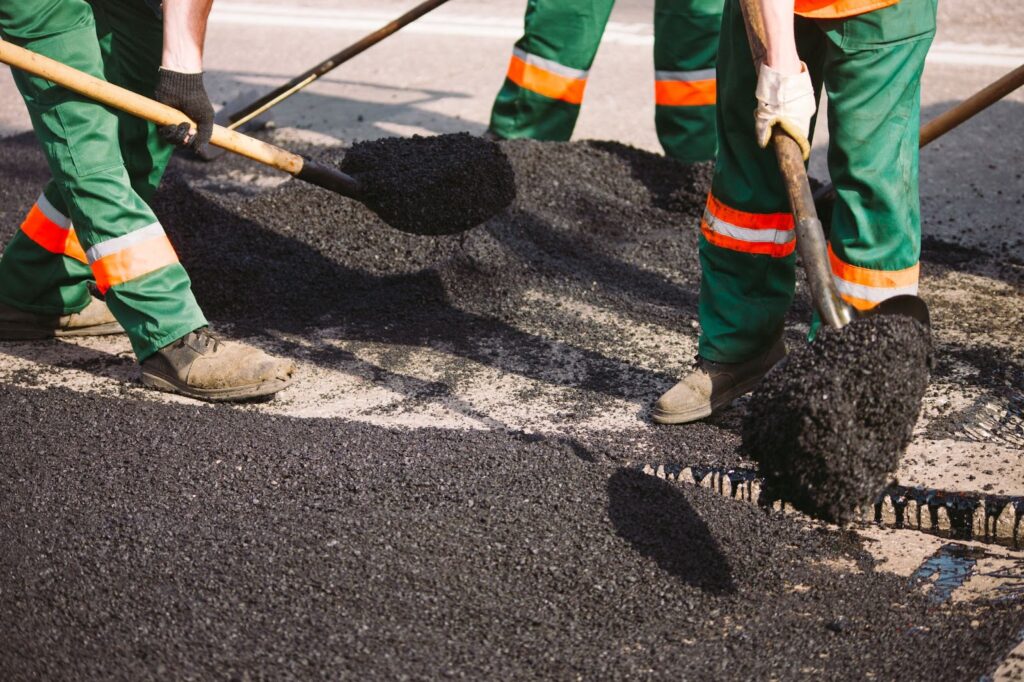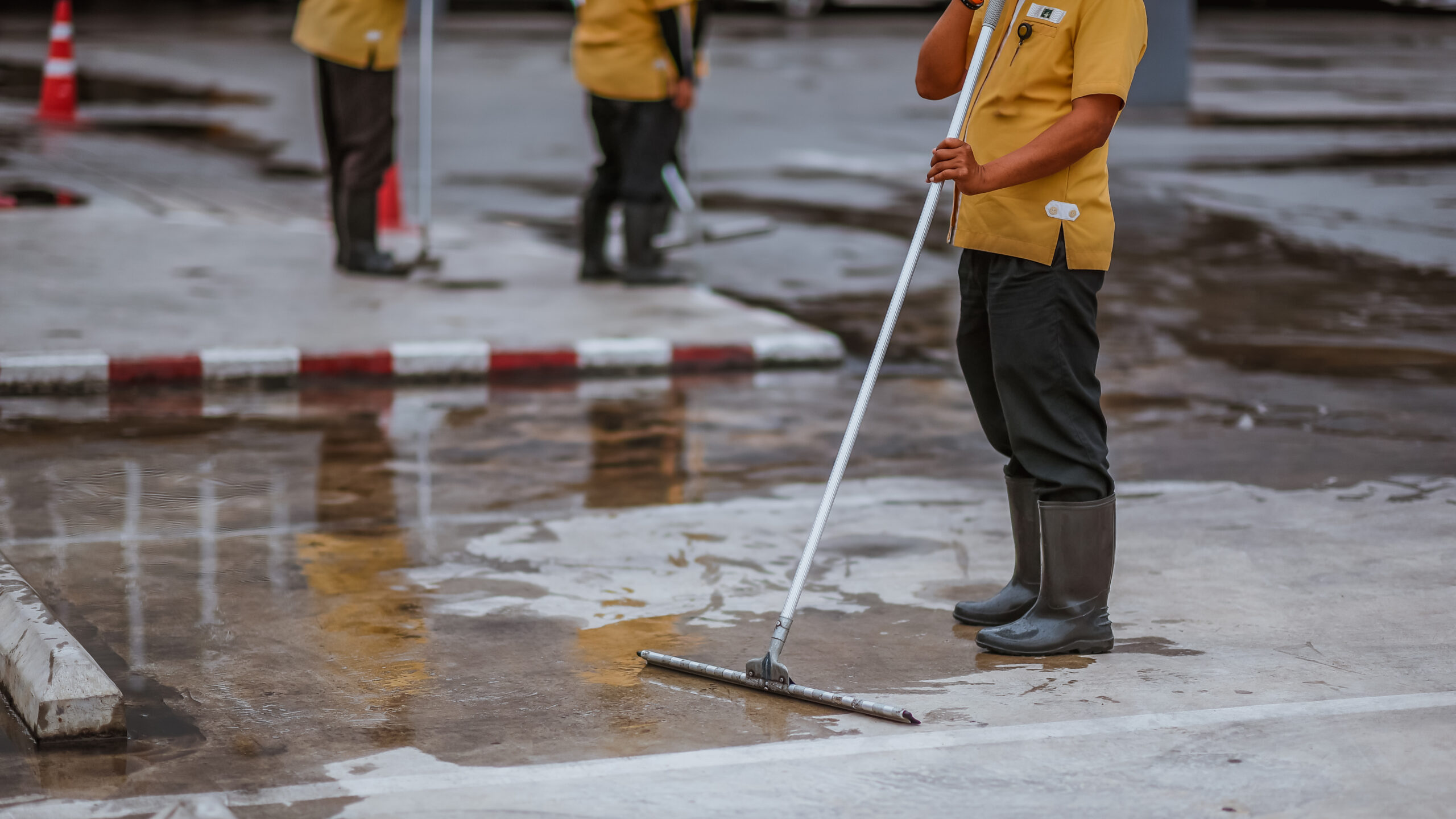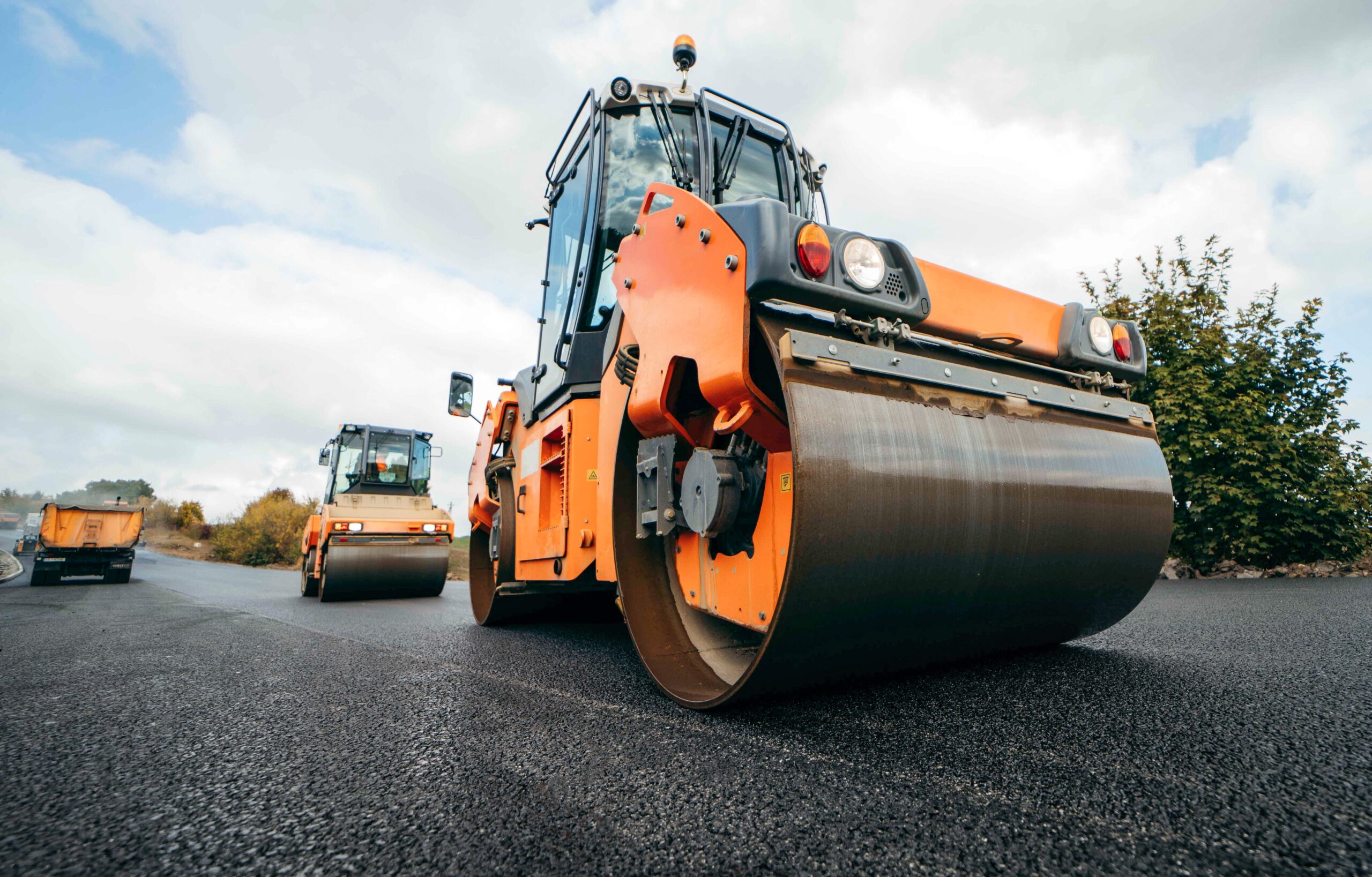Asphalt repair encompasses targeted techniques, such as crack filling, patching, seal coating, or resurfacing, designed to address damage or wear on asphalt surfaces without resorting to full reconstruction. These repairs are vital for preserving pavement integrity, extending its usable life, and preventing minor defects from escalating into costly replacements.
According to industry estimates, the cost of resurfacing vs replacing asphalt shows that resurfacing often runs between $3 and $7 per square foot. At the same time, full replacement typically ranges from $7 to $15 per square foot, making asphalt repair services a far more cost-effective choice.
Proper preparation before undertaking asphalt repair is crucial: factors like drainage, compaction, and subbase condition profoundly influence the longevity and effectiveness of repairs. Overlooking these can lead to premature failure and repeated interventions. This guide will help you assess damage accurately, choose the right repair approach, and ensure long-lasting results.
What is Asphalt Repair?
Asphalt repair refers to the array of techniques used to fix worn, cracked, or damaged asphalt surfaces, ranging from minor interventions like crack sealing to more substantial fixes such as resurfacing or complete reconstruction. Its primary goal is to restore the functionality, safety, and durability of pavement without the need for full replacement.

You can find detailed federal guidelines in the FHWA Pavement Maintenance & Preservation program.
Common Types of Asphalt Repairs
Here are some of the most common types of asphalt repairs:
- Crack Sealing: A preventive method where rubberized sealant fills surface cracks to keep moisture out and delay deterioration.
- Pothole Patching: Targets localized failures using either temporary cold mix or more durable hot mix asphalt.
- Resurfacing (Overlay): Applies a fresh asphalt layer over stable underlying pavement to renew surface quality.
- Sealcoating: A protective coating against UV rays, water, and chemicals; it preserves existing pavement rather than repairing damage.
- Full-Depth Repair / Reconstruction: Used for structural failures and replaces damaged layers down to the base.
Why Asphalt Repair is Important
Asphalt surfaces, whether it’s a driveway, parking lot, or roadway, naturally wear down over time due to traffic, weather, and age. Small cracks and potholes may seem like minor issues at first, but if left untreated, they can quickly spread, weaken the pavement structure, and lead to far more expensive repairs.
Timely asphalt repair not only keeps your pavement looking good but also protects its foundation from water damage and erosion. It is similar to fixing a small leak in your roof; deal with it early, and you’ll avoid a costly overhaul later. The National Asphalt Pavement Association’s Best Practices guide offers more data on how preventive measures save long-term costs.
In fact, studies show that delaying maintenance can increase repair costs by up to six times after just three years, and up to 18 times after five years. That means a quick, affordable fix today could save you thousands in the long run.
Key Considerations Before Starting Asphalt Repair
Before you begin any asphalt repair project, proper planning is essential to avoid wasted effort and unnecessary expenses. Addressing these factors beforehand will help ensure a repair that lasts and delivers the best value for your investment.
- Assessing the Condition of Your Asphalt
Start with a thorough inspection to identify visible issues such as cracks, potholes, ruts, or drainage problems. A professional asphalt assessment can also reveal hidden weaknesses in the subbase that may impact repair choices.
- Understanding the Extent of the Damage
Small, isolated cracks may only require sealing, while large potholes, widespread crumbling, or surface fatigue might call for resurfacing or full-depth reconstruction. Choosing the right repair method depends on accurately gauging the severity and scope of the damage.
- Traffic and Accessibility Considerations
Think about how the surface is used daily. Light vehicle driveways have different repair needs than heavy truck loading zones or high-traffic parking lots. Also, plan for how repair work will impact accessibility and whether temporary closures will be needed.
- Cost Factors and Budgeting
Establish a realistic budget that includes both the immediate repair work and preventive measures such as sealcoating or drainage improvements. Investing slightly more in high-quality materials can often extend pavement life and reduce future costs.
- Timing and Weather Conditions
Asphalt repairs cure best in warm, dry conditions. Scheduling during optimal weather ensures better bonding and durability, while working in cold or wet conditions can lead to premature failure.
- Long-Term Maintenance Planning
Repairs are most effective when paired with ongoing maintenance. Regular inspections, timely crack sealing, and sealcoating every few years will maximize the lifespan of your asphalt and protect your investment.
When to Choose Asphalt Repair Over Full Replacement
Not every damaged asphalt surface needs to be torn up and replaced. Sometimes, targeted repairs can restore function and appearance for a fraction of the cost, while in other cases, replacement is the only way to ensure long-term durability. Understanding the difference can save you both time and money.
On average, asphalt repair, such as crack sealing, patching, or resurfacing, costs between $3 and $7 per square foot, whereas complete replacement often runs $7 to $15 per square foot or more. Repairs are faster, less disruptive, and more budget-friendly, but they only work if the underlying pavement structure is still sound. Although more expensive, replacement addresses deeper issues and resets the lifespan of the pavement entirely.
Signs Asphalt Repair is Sufficient
You can often opt for asphalt repair if:
- Cracks are less than ¾ inch wide and not spreading rapidly.
- Damage is localized to specific spots rather than across the entire surface.
- The base layer is stable with no signs of sinking or soft spots.
- Potholes are shallow and limited in number.
- Surface wear is cosmetic (fading, light raveling, or surface roughness) without any structural issues.
- The pavement is relatively new and has not reached the end of its expected lifespan.
In these cases, repairs like crack sealing, patching, or sealcoating can extend the life of the asphalt by several years without the cost of full replacement.
When Full Asphalt Replacement is Needed
Full replacement becomes necessary when damage goes beyond the surface and compromises the pavement’s structural integrity, such as:
- Widespread alligator cracking (interconnected cracks resembling reptile skin).
- A failed or unstable base layer, causing dips, depressions, or soft spots.
- Extensive water damage has eroded the subbase.
- Potholes that are deep, numerous, and recurring despite prior repairs.
- Asphalt that is more than 20–25 years old and has exceeded its service life.
- Severe drainage problems that repairs alone cannot fix.
In these situations, patching or resurfacing would be temporary and costly in the long run, making full replacement the smarter investment.
How Long Does Asphalt Repair Take?
The time required for asphalt repair depends on the size of the project, the repair method used, and external factors like weather and site conditions. Smaller jobs can often be completed in just a few hours, while large-scale repairs or resurfacing projects may take several days. Understanding the timeline helps with planning, budgeting, and minimizing disruptions.
Timeframe for Small Projects
If you’re dealing with minor asphalt issues, the repair process is often quick and efficient, causing minimal disruption. These smaller jobs can often be completed in just a few hours, allowing you to get your driveway or lot back in use quickly. Some small projects and their estimated timelines are,
- Crack Sealing: Often completed in 1–2 hours for small driveways, or within a single day for larger areas.
- Pothole Patching: A small pothole can be repaired in 30–60 minutes, while multiple potholes across a lot may take a few hours.
- Sealcoating (small driveway): Usually finished in a few hours, but needs 24–48 hours for full curing before traffic resumes.
Timeframe For Large Projects
On the other hand, large-scale asphalt repairs require more planning, labor, and drying time. These projects take longer because they involve greater surface areas, heavier equipment, and sometimes more extensive prep work, like:
- Driveway resurfacing usually involves 1–2 days of work plus 48–72 hours of drying time before light traffic is safe.
- Resurfacing larger areas, like commercial parking lots, typically takes several days to a week, depending on size, prep work, and weather.
While estimating timeframes provides a clear starting point for scheduling, real-world conditions often force adjustments. Even well-prepared crews can face obstacles that push back completion dates.
Common Challenges in Asphalt Repair Projects
Even with the best planning, asphalt repair projects can face delays or complications that affect timelines, budgets, and final results. Understanding these challenges ahead of time helps contractors and property owners take preventive measures.
Weather Delays and Their Impact
Asphalt work is highly sensitive to weather. Rain, snow, or excessive humidity can halt operations because moisture prevents proper bonding of the asphalt mix. So, choosing the right asphalt mix in extreme temperatures can also impact curing time and compaction quality.
For example, cold weather shortens the working time for asphalt before it hardens, while excessive heat can make the surface too soft for immediate use. This can extend timelines by days or even weeks, depending on local climate patterns.
Equipment and Operational Issues
Breakdowns of paving machines, rollers, or trucks can cause significant interruptions. Delays also occur when equipment is not calibrated correctly, leading to uneven surfaces or improper compaction that must be redone.
Material Supply Constraints
Hot mix asphalt must be delivered and used quickly while it’s at the correct temperature. If the supply plant is far from the job site, or if there are delays in delivery due to traffic or logistical problems, the material can cool too quickly, leading to quality issues.
Unexpected Subsurface Problems
Once the top asphalt layer is removed, hidden problems may emerge, such as unstable base layers, poor drainage systems, or buried utilities. Addressing these requires additional materials, labor, and time, which can quickly increase costs and extend deadlines.
The Equipment Used in Asphalt Repair
Asphalt repair projects rely heavily on specialized machinery designed to ensure efficiency, precision, and long-term durability. The right equipment not only speeds up the work but also improves the quality of the repair, reducing the need for repeat maintenance.
Below is a breakdown of key equipment and its specific applications in different repair scenarios.
Patching Machines
Patching machines are essential for filling potholes and repairing damaged asphalt. They allow workers to heat, mix, and apply asphalt quickly, which improves efficiency and reduces downtime. For minor repairs, portable patching units can be used, while large truck-mounted machines are ideal for bigger jobs. Choosing the right equipment ensures cost-effective repairing damaged asphalt, saving both time and money while maintaining the quality of the surface.
Crack Sealing Machines
Crack sealing machines inject hot or cold sealant directly into cracks, preventing water from seeping underneath and causing further damage. These machines are especially valuable for extending the life of asphalt by stopping minor issues from becoming major repairs.
Additional Support Equipment
- Infrared Heaters: Soften existing asphalt for seamless patch blending.
- Tack Distributors: Apply a bonding layer between old and new asphalt.
- Hand Tools: Shovels, rakes, and lutes are still necessary for fine adjustments and small-area repairs.
By matching the right equipment to the repair task, contractors can improve both the speed and the quality of asphalt work, ultimately saving time, labor, and long-term maintenance costs.
Environmental Considerations in Asphalt Repair
Asphalt repair is increasingly recognized as a more sustainable alternative to full surface replacement, offering both environmental and cost-saving benefits. By reusing existing materials and minimizing the need for new resources, repair projects can significantly reduce their ecological footprint. This shift toward greener practices is primarily driven by advancements in recycling methods and waste reduction strategies.
Recycling and Reusing Asphalt
A major contributor to sustainable asphalt repair is the use of Reclaimed Asphalt Pavement (RAP). This involves milling and processing old asphalt so it can be incorporated into new repair mixtures. RAP not only reduces the demand for virgin aggregates and bitumen but also lowers energy consumption and greenhouse gas emissions associated with material production.
By implementing these recycling methods, repair projects can cut down on both material costs and environmental impact, making them more efficient and eco-conscious. This naturally leads to another critical aspect of sustainability and waste reduction. According to the U.S. Environmental Protection Agency, using recycled materials like RAP significantly cuts greenhouse gas emissions.
Waste Reduction in Asphalt Repairs
Targeted repair strategies naturally generate far less waste than full replacement projects. By addressing only damaged sections, whether through patching, crack sealing, or localized resurfacing, contractors avoid sending large quantities of usable material to landfills. Additionally, choosing eco-friendly binders and sealants with low volatile organic compounds (VOCs) helps reduce environmental impact while improving air quality during application.
How to Prepare for an Asphalt Repair Project
Preparing properly for an asphalt repair project can make all the difference between a quick, high-quality job and one filled with delays or unexpected issues. A well-prepared site allows contractors to work more efficiently, helps you avoid unnecessary costs, and ensures the finished surface lasts longer.
Here’s a step-by-step guide to help you get ready.
Step 1. Clear the Area of Debris and Obstructions
Before repair work begins, remove any loose debris, gravel, branches, or other objects from the surface. This not only gives contractors a clean workspace but also helps them accurately assess the damage.
Step 2. Ensure Proper Drainage
Standing water is one of asphalt’s biggest enemies, and repairs done without addressing drainage issues may not last. Check for blocked drains or areas where water pools after rain. If needed, speak to your contractor about minor grading adjustments before repairs begin.
Step 3. Mark Off the Repair Zone
Use cones, tape, or temporary barriers to clearly mark the areas that need work. This helps prevent accidental damage to nearby surfaces and keeps pedestrians or vehicles out of the work zone for safety reasons.
Step 4. Make the Site Easily Accessible
Contractors often bring in heavy machinery such as pavers, patching machines, or rollers. Ensure they have enough space to move equipment in and out without difficulty. So, you should,
- Remove any temporary fences or barriers in the way.
- Provide an alternate parking space for residents or employees during work.
Step 5. Communicate Clearly with Your Contractor
Clear, upfront communication with your asphalt repair contractor can be the difference between a stress-free project and costly misunderstandings. Before work begins, provide a detailed description of the damage, including when it appeared and whether it has worsened over time. Share photos or let them inspect the site in person for accuracy.
Finally, keep a direct communication channel open during the project, whether that’s phone, email, or text, so that any unexpected issues can be resolved quickly without delays.
Final Tip – Stay Involved, But Don’t Interfere
Being present on the day of the repair ensures any last-minute questions can be addressed quickly. However, allowing the crew to work without interruptions, trusting professionals, leads to the best outcome.
Cost of Asphalt Repair
The breakdown of costs is outlined below, though these figures can vary over time due to factors like material prices, labor rates, and regional differences.
Estimating the Cost
Repairing an asphalt driveway generally ranges between $250 and $800, depending on the severity of damage and the method used. Surface issues like cracks or small potholes typically fall on the lower end of this range, while more extensive patching can push it higher.
On average, homeowners spend around $2,461 on asphalt driveway repairs, though prices can dip as low as $100 for minor crack filling or climb as high as $4,017 for complete resurfacing.
Estimating Based on Situation
If you’re tackling a small project, say, a few cracks or a single pothole, budgeting $100 to $400 could be sufficient. Larger repairs involving resurfacing can range from $1,200 to $3,000, depending on driveway size and condition.
Quick Value Summary
- Minor repairs: $100 to $400
- Resurfacing: $1,200 to $3,000 on average
- Resurfacing per sq. ft.: $3–7
- Full replacement per sq. ft.: $7–15
This cost breakdown helps you plan realistically, whether you’re dealing with small fixes or considering whether complete replacement is worth the investment.
Long-Term Benefits of Asphalt Repair
Investing in regular asphalt repair is more than just a short-term fix; it’s a smart, long-term strategy. By addressing issues early and maintaining the surface regularly, you protect your investment, reduce future expenses, and ensure that your pavement remains safe, functional, and attractive for years to come.
Extended Asphalt Lifespan
Timely and proactive maintenance, such as sealcoating and crack sealing, can significantly prolong the life of asphalt surfaces. One industry insight highlights that annual sealcoating can reduce reconstruction costs by up to 62% over a decade by preventing deep structural deterioration. Additionally, routine maintenance can delay the need for complete pavement reconstruction, helping maintain functionality longer.
Cost Savings from Early Repair
Addressing minor damage early, such as small cracks or surface wear, is far more economical than waiting until major repairs are required. Preventive actions like sealcoating and crack filling cost only a fraction of full resurfacing or reconstruction. Moreover, a proactive maintenance strategy spreads expenses over time and helps avoid sudden, unexpected financial burdens.
FAQs
How long does asphalt repair last?
The lifespan of an asphalt repair depends on the repair method, material quality, and traffic load. Minor crack fillings may last 3–5 years, while patching and resurfacing can extend the life of the surface by 7–15 years if maintained properly. Regular sealcoating and prompt attention to new damage can significantly prolong these timelines.
How much does asphalt repair cost?
On average, asphalt repair costs range from $250 to $800, depending on the severity and type of damage. Filling small cracks is on the lower end, while repairing deep potholes or resurfacing larger areas falls toward the higher range. Local labor rates, materials, and accessibility can also affect the total cost.
Can asphalt repairs be done in cold weather?
While cold-weather repairs are possible, they often require exceptional cold mix asphalt that is less durable than hot mix asphalt used in warmer months. Cold mix is a temporary solution, ideal for emergency fixes during winter, but should be followed up with a permanent repair once temperatures rise above 50°F (10°C).
What is the best time of year for asphalt repairs?
The best time for asphalt repairs is late spring through early fall, when temperatures are consistently warm. Hot mix asphalt bonds better and cures faster in warmer weather, ensuring a more durable result. Dry, mild days are optimal to avoid moisture-related issues during application.
Ready to Protect and Improve Your Asphalt?
Regular asphalt maintenance and timely repairs are key to extending surface life, improving safety, and enhancing curb appeal. By addressing issues early, you can save money, avoid costly reconstructions, and keep your pavement looking its best year-round. Whether it’s a small crack or a complete sealcoating job, taking action now ensures your asphalt stays strong and functional for years to come.
Don’t wait until minor problems turn into major expenses. Contact Asphalt Coatings Company today for a professional consultation or to schedule your repair assessment. Our experts are here to deliver durable, high-quality solutions tailored to your needs.




